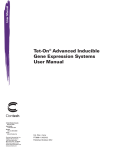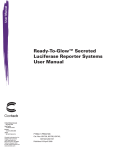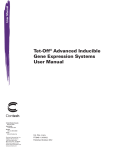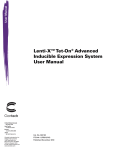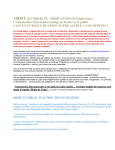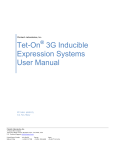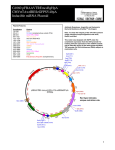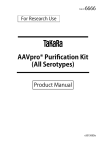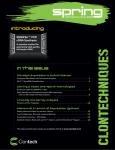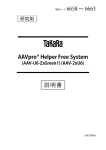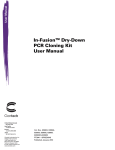Download Mir-X™ Inducible miRNA Systems User Manual
Transcript
User Manual Mir-X™ Inducible miRNA Systems User Manual United States/Canada 800.662.2566 Asia Pacific +1.650.919.7300 Europe +33.(0)1.3904.6880 Japan +81.(0)77.543.6116 Clontech Laboratories, Inc. A Takara Bio Company 1290 Terra Bella Ave. Mountain View, CA 94043 Technical Support (US) E-mail: [email protected] www.clontech.com Cat. Nos. 631118, 631119, 631120 & 631121 PT5050-1 (PR963263) Published 15 August 2009 Mir-X™ Inducible miRNA Systems User Manual Table of Contents I. Introduction............................................................................................................................. 3 A. Summary............................................................................................................................................. 3 B. Elements of Tet-On Advanced Induction............................................................................................. 3 C. Benefits of the Tet-Advanced Expression Systems................................................................................. 4 D. Doxycycline......................................................................................................................................... 4 II. List of System Components................................................................................................... 5 III. Additional Materials Required................................................................................................ 5 IV. Protocol Overview................................................................................................................... 7 A. General Cell Culture . ......................................................................................................................... 7 B. Establishing the Mir-X Inducible miRNA System in Target Cells........................................................ 7 V. Plasmid and miRNA Vector Preparation................................................................................ 8 A. General Molecular Biology Techniques................................................................................................ 8 B. Isolating Your miRNA Sequence.......................................................................................................... 8 C. Plasmid Propagation & Construction of Your miRNA Expression Vector............................................ 8 VI. Developing a Stable Tet-On Advanced Cell Line................................................................... 9 A. Protocol: Pilot Testing Tet-Based Induction in Target Cells.................................................................. 9 B. Protocol: Creating a Stable Tet-On Advanced Cell Line from Your Target Cell Line........................... 10 C. Protocol: Testing Your Tet-On Advanced Clones for Induction.......................................................... 10 VII. Developing the Double-Stable Mir-X System Cell Line .................................................... 11 A. Protocol: Creating the Double-Stable Mir-X System Cell Line........................................................... 11 B. Screening Your Panel of Double-Stable Mir-X Cell Lines................................................................... 11 VIII.References.............................................................................................................................. 12 Appendix A: Vector Information.................................................................................................. 13 Appendix B: Additional Protocols............................................................................................... 14 A. Protocol: Titrating Antibiotics for Selecting Stable Cell Lines............................................................ 14 List of Figures Figure 1. Induction in the Tet-On Advanced System.................................................................................. 3 Figure 2. Tetracycline activity in bovine sera............................................................................................... 6 Figure 3. Establishing the Mir-X Inducible miRNA System (Red) in target cells........................................ 7 Figure 4. Map of pTet-On Advanced........................................................................................................ 13 Figure 5. Map of the pmRi-mCherry and pmRi-ZsGreen1 Vectors.......................................................... 13 Figure 6. Map of the pTRE-Tight-Luc Vector.......................................................................................... 13 Protocol No. PT5050-1 www.clontech.com Version No. PR963263 2 Clontech Laboratories, Inc. A Takara Bio Company Mir-X™ Inducible miRNA Systems User Manual I. Introduction A. Summary The Mir-X Inducible miRNA Systems (Red & Green) employ elements of our tightly regulated and highly responsive Tet-On® Advanced Expression System to produce on-demand and high-level expression of miRNAs (Clontechniques, April 2006). Mir-X Inducible Systems are established by sequentially transfecting the provided vectors into your target cells and selecting stable cell lines. Cells that express the Tet-On Advanced transactivator, and that also bear an integrated pmRi-mCherry or pmRi-ZsGreen1 miRNA expression vector, will express high levels of the miRNA along with a red or green fluorescent protein marker, when cultured in the presence of doxycycline (Dox) (Figure 1). B. Elements of Tet-On Advanced Induction Based on the original tetracycline (Tc)-regulated transcriptional transactivators described by Gossen & Bujard (1992) and Gossen et al. (1995), Tet-On Advanced is a modified transactivator protein that is optimized for expression in mammalian cells, and which demonstrates higher sensitivity and fidelity than previous versions (Urlinger, et al. 2000; Clontechniques, January 2007). The inducible promoter, PTight, provides for very low basal expression and tightly controlled induction. • The Tet-On Advanced transactivator. The pTet-On Advanced Vector constitutively expresses the tetracycline-controlled transcriptional transactivator, Tet-On Advanced (Urlinger et al., 2000). This engineered protein consists of a mutant E. coli TetR protein (rTetR) fused to three minimal "F”-type activation domains derived from the herpes simplex virus VP16 protein (Baron et al., 1997, Triezenberg et al., 1988). In the presence of Dox, Tet-On Advanced binds to the tetO sequences in PTight, and activates high level transcription from this inducible promoter. The Tet-On Advanced coding sequence is fully synthetic and utilizes human codon preferences to increase its expression level and stability in mammalian cells. • The inducible miRNA expression vectors: pmRi-mCherry and pmRi-ZsGreen1. The central feature of these vectors is the inducible promoter, PTight , which controls transcription of the mCherry or ZsGreen1 fluorescent protein mRNAs that also contain your miRNA sequence embedded in their 3’ UTRs. The PTight composite promoter sequence was originally developed as the Ptet-14 promoter in the laboratory of Dr. H. Bujard and consists of a modified Tet-Responsive Element (TREmod) joined to a minimal CMV promoter (PminCMV∆) (Clontechniques, April 2003). PTight also lacks binding sites for endogenous mammalian transcription factors, so it is virtually silent in the absence of induction. In the presence of Dox, Tet-On Advanced binds tightly and specifically to the PTight promoter and activates transcription of the fluorescent protein/miRNA transcript (Figure 1). + Dox Tet-On Advanced tTA-Advanced 3X (min VP16) 3X (min VP16) Transcription Transcription CMVmin∆ TREMOD PTight TREMOD CMVmin∆ PTight Gene of interest Tet-Off Advanced mCherry/ZsGreen1 + miRNA in 3’ UTR Tet-On Advanced System Figure 1. Induction in the Tet-On Advanced System. The Tet-controlled transactivator, Tet-On Advanced, is a fusion protein derived from a mutant version of the E. coli Tet repressor protein, rTetR, which is joined to three minimal transcription activation domains. In the presence of doxycycline (Dox), Tet-On Advanced binds to the tetracycline response element (TREMod) in PTight, and produces high-level transcription of the downstream gene. In the Mir-X miRNA Inducible Systems, the mRNA transcript encodes a fluorescent protein (mCherry or ZsGreen1) and an miRNA sequence in the 3’ UTR. ® Clontech Laboratories, Inc. www.clontech.com A Takara Bio Company Protocol No. PT5050–1 Version No. PR963263 3 Mir-X™ Inducible miRNA Systems User Manual I. Introduction continued C. Benefits of the Tet-Advanced Expression Systems The Tet-On Advanced System produces very high maximal expression coupled with extremely low basal expression to yield very high induction levels that are both highly sensitive and concentration dependent. Advantages over other inducible mammalian gene expression systems are listed below. • Extremely tight regulation. In the absence of induction, the Tet-On Advanced transactivator shows virtually no residual binding to the TRE in PTight. Thus, basal expression is extremely low and often undetectable. • Highly specific. The Tet-Advanced TetR portion of the transactivator binds very specifically to the tetO target sequences of PTight and does not activate off-target cellular genes. This high degree of specificity may be due in part to the prokaryotic nature of these components acting within the context of a large eukaryotic genome lacking similar elements (Harkin et al., 1999). • No pleiotropic effects. Tc and Dox are prokaryotic antibiotics that have no detectable effects eukaryotic cells when used at the concentrations required by the Tet-Advanced Systems, • High inducibility and fast response times. In properly screened clones, maximal induction of the Tet-On Advanced System is often several thousand-fold and can be detected within 30 minutes after addition of Dox to the culture medium. In contrast, other mammalian systems often exhibit slow induction (up to several days), incomplete induction (compared to repressor-free controls), and low overall induction (often no more than 100-fold). Other systems may also require high, nearly cytotoxic levels of inducer (reviewed by Gossen et al., 1993; Yarronton, 1992). • Highest absolute expression levels. Maximal expression levels in the Tet Systems can be higher than expression levels obtained from the CMV promoter or other constitutive promoters. For example, Yin et al. (1996) reported that the maximal level of luciferase expression in HeLa Tet-Off cells transiently transfected with pTRE-Luc is 35-fold higher than that obtained with HeLa cells transiently transfected with a plasmid expressing luciferase from the wild-type CMV promoter. • Well-characterized effector. In contrast to effectors used in other systems, such as ecdysone, Dox is inexpensive, well-characterized, and yields highly reproducible results. Dox binds with high affinity to Tet-On Advanced and is essentially nontoxic at the effective concentrations. Note that Tet-On Advanced Systems respond only to Dox, and not to Tc (Gossen & Bujard, 1995). • Promoter activation is superior to repression. Repression-based systems require very high levels of repressor to ensure 100% occupancy of the regulatory sites and fully shut-off transcription. The presence of high repressor levels also prevents rapid, high-level induction (Yao et al., 1998). For a more complete discussion of the advantages of transcription activation versus repression, see Gossen et al. (1993). • The Tet-On Advanced and Tet-Off Advanced Systems offer versatile expression control strategies for transgenic mice. The Tet System has become the de facto method of choice for generating reversibly inducible transgenic lines (Gossen & Bujard, 2002). More than 280 mouse lines have been described that express the Tet transactivator genes under the control of a variety of tissue-specific promoters or express various target genes under control of Tet-inducible promoters. A list of these mouse lines can be found on the TET Systems website (http://www.tetsystems.com/support/transgenic-mouse-lines/). With its greatly increased sensitivity to Dox, the Tet-On Advanced System brings additional advantages to the development of inducible transgenic mice. This may be particularly helpful when control of gene expression in the brain is required, as the presence of the blood-brain barrier limits the concentration of Dox that can be attained in the brain. D. Doxycycline The doxycycline concentrations required for induction with Tet-On Advanced Systems are far below cytotoxic levels for either cell culture or transgenic studies. Of note, Tet-On Systems respond only to Dox, and not to Tc (Gossen & Bujard, 1995). Protocol No. PT5050-1 www.clontech.com Version No. PR963263 4 Clontech Laboratories, Inc. A Takara Bio Company Mir-X™ Inducible miRNA Systems User Manual II. List of System Components Store all components at –20°C. Mir-X Inducible miRNA System (Red), (Cat. No. 631118) and Mir-X Inducible miRNA System (Green), (Cat. No. 631120) Package Contents • 20 µg pTet-On Advanced Vector (500 ng/µl; Cat. No. 631069) • 20 µg pmRi-mCherry Vector (500 ng/µl; Cat. No. 631119) Red system only, or 20 µg pmRi-ZsGreen1 Vector (500 ng/µl; Cat. No. 631121) Green system only. –– 20 µg pTRE-Tight-Luc Vector (500 ng/µl) –– 40 µl Linear Hygromycin Marker (50 ng/µl) –– 40 µl Linear Puromycin Marker (50 ng/µl) • 50 ml Tet System Approved FBS, US-Sourced (50 ml; Cat. No. 631105). (Also available in 500 ml size, Cat. No. 631101). Product Documents and Manuals (available at www.clontech.com/manuals) • Mir-X Inducible miRNA Systems User Manual (PT5050-1) • pTet-On Advanced Vector Information (PT3899-5) • pmRi-mCherry Vector Information (PT5048-5) Red system only, or pmRi-ZsGreen1 Vector Information (PT5049-5) Green system only. Visit www.clontech.com for a current list of products and cell lines available for the Tet Systems. III. Additional Materials Required A. Mammalian Cell Culture Supplies • Culture medium, supplies, and additives specific for your target cells. • Tetracycline-free fetal bovine serum (FBS; see important information below). We strongly recommend using Tet System Approved FBS (Cat. Nos. 631101 & 631106) for culturing target cells containing Tet Systems. • Cloning cylinders or discs for isolating colonies of adherent cell lines (PGC Scientific, Cat. No. 62-6150-40, -45 or Cat. No. 62-6151-12, -16) • Cell Freezing Medium, with or without DMSO (Sigma, Cat. No. C6164 or Cat. No. C6039) for freezing single-stable Tet-On Advanced cell lines and double-stable Mir-X cell lines [Optional]. B. Antibiotics for Selecting Stable Cell Lines Prior to using antibiotics to select stable cell lines from your transfected cells, determine the optimal selection concentration for each antibiotic as described in Appendix A. For example, the G418 concentration range for selecting stable HeLa cell lines is 400–500 µg/ml. • G418, for selecting single-stable Tet-On Advanced cell lines. G418 is available from Clontech (Cat. No. 631307). Note that the effective weight is approximately 0.7 g per gram of powder. Make a 10 mg/ml stock solution by dissolving 1 g of powder in approximately 70 ml of culture medium (without supplements). Filter sterilize and store at 4°C. –– Concentration range for selecting stable cell lines: 50–800 µg/ml –– Maintenance of stable cell lines: 100 µg/ml –– Selection concentration (e.g., HEK 293, HeLa cells): 400–500 µg/ml Clontech Laboratories, Inc. www.clontech.com A Takara Bio Company Protocol No. PT5050–1 Version No. PR963263 5 Mir-X™ Inducible miRNA Systems User Manual III. Additional Materials Required continued B. Antibiotics for Selecting Stable Cell Lines (cont’d) • Hygromycin, for selecting double-stable Mir-X System cell lines transfected with the Linear Hygromycin Marker. Hygromycin B is available from Clontech (Cat. No. 631309). –– Concentration range for selecting stable cell lines: 50–800 µg/ml –– Maintenance of stable cell lines: 100 µg/ml • Puromycin, for selecting double-stable Mir-X System cell lines transfected with the Linear Puromycin Marker. Puromycin is available from Clontech (Cat. Nos. 631305 & 631306) –– Concentration range for selecting stable cell lines: 0.25–10 µg/ml –– Maintenance of stable cell lines: 0.25 µg/ml C. Transfection Reagents • Xfect™ is a novel, highly efficient, and versatile transfection reagent that forms biodegradable nanoparticles and produces superior transfection results for a wide variety of mammalian cell types (Cat. Nos. 631317 & 631318). • The CalPhos™ Mammalian Transfection Kit is a highly efficient calcium-phosphate-based transfection system (Cat. No. 631312). D. Doxycycline Doxycycline (Cat. No. 631311) is needed for activating Tet-On Advanced and inducing expression of the miRNA and fluorescent protein marker. Dilute to 1–2 mg/ml in H2O. Filter sterilize, aliquot, and store at –20°C in the dark. Use within one year. E. Luciferase Assay A method for assaying luciferase expression is required when using the pTRE-Tight-Luc vector to screen Tet-On Advanced clones. Use any standard luciferase assay system and luminometer. Attention F. Tetracycline-Free Fetal Bovine Serum (FBS) for Target Cell Culture Many lots of bovine sera are contaminated with tetracycline (Tc) or Tc-derivatives which can affect basal expression or inducibility in Tet Systems (Figure 2). It is critical that the FBS used for cell culture not interfere with Tet-responsive expression. • Tc-contaminants will diminish the performance of Tet-On Advanced-based systems by elevating basal expression and reducing fold-induction. • These problems can be eliminated by using a Tet System Approved FBS (Cat. Nos. 631101 & 631106) from Clontech. These sera have been functionally tested in our Tet Systems and found to be free of contaminating Tc activity. Fold-induction 15 x 103 10 x 103 5 x 103 Tet System Other commercially Approved FBS available FBS Figure 2. Tetracycline activity in bovine sera. The CHO-AA8-Luc Tet-Off Control Cell Line was grown in media prepared with different lots of FBS. Average uninduced expression level = 0.21 RLU (n=21, S.D.=0.07); maximum expression levels varied from 123 to 3,176 RLU. Protocol No. PT5050-1 www.clontech.com Version No. PR963263 6 Clontech Laboratories, Inc. A Takara Bio Company Mir-X™ Inducible miRNA Systems User Manual IV. Protocol Overview Please read these protocols in their entirety before starting Successful results depend on understanding and performing the following steps correctly. A. General Cell Culture This user manual provides only general guidelines for mammalian cell culture techniques. Perform all steps involving cell culture using sterile technique in a tissue culture hood. For users requiring more information on mammalian cell culture, transfection, and creating stable cell lines, we recommend the following general reference: • Culture of Animal Cells, 5th Edition, by R. I. Freshney (2005, Wiley-Liss, NY) B. Establishing the Mir-X Inducible miRNA System in Target Cells The general strategy for establishing the Mir-X Inducible miRNA System is shown in Figure 3, in which target cells are first transfected with pTet-On Advanced to create a stable cell line. Once a suitable Tet-On Advanced cell line (clone) is identified, then this cell line is stably transfected with your customized pmRi-mCherry (or -ZsGreen1) vector. Target cells PCMV 1. Transfect target cells with pTet-On Advanced. Select for stably transfected cells. G418 selection Neor Tet-On pTet-On Advanced Advanced 2. Pick ≥30 colonies/clones; expand and screen for inducibility. Carry forward best clone. Tet-On Advanced cell line PTight 3. Transfect Tet-On Advanced target cell line with pmRi-mCherry and linear marker. Select for stably transfected cells. 4. Pick clones; expand, and screen or sort cells for mCherry expression induced by Dox. Dox also induces miRNA expression. Hygromycin or puromycin selection − Dox pmRi- mCherry mCherry miRNA + r r Hyg /Pur + Dox Target cell line containing a Mir-X Inducible miRNA System miRNA OFF miRNA ON No expression of mCherry or miRNA High expression of mCherry and miRNA Figure 3. Establishing the Mir-X Inducible miRNA System (Red) in target cells. Target cells are transfected with the pTet-On Advanced plasmid and selected with G418 to generate a stable Tet-On Advanced cell line. This cell line serves as the host for the pmRi-mCherry miRNA expression vector, which is transfected into the Tet-On Advanced cell line along with one of the linear markers. After a second round of drug selection, a stable cell line is produced which will coexpress the miRNA and mCherry in response to doxycycline (Dox). Clontech Laboratories, Inc. www.clontech.com A Takara Bio Company Protocol No. PT5050–1 Version No. PR963263 7 Mir-X™ Inducible miRNA Systems User Manual V. Plasmid and miRNA Vector Preparation A. General Molecular Biology Techniques Only general information for propagating and purifying plasmid vectors is provided below. For users requiring detailed information on plasmid propagation and cloning, we recommend the following laboratory references: • Current Protocols in Molecular Biology ed. by F. M. Ausubel et al. (1995, John Wiley & Sons, NY). • Molecular Cloning: A Laboratory Manual ed. by J. Sambrook et al. (2001, Cold Spring Harbor Laboratory Press, NY). B. Isolating Your miRNA Sequence We recommend that you use PCR and specific primers to amplify and isolate a small genomic fragment containing your miRNA precursor of interest. This fragment will be cloned in the pmRi-mCherry (or -ZsGeen1) vector and should be positioned in the same orientation as the fluorescent protein. In addition to the miRNA precursor sequence itself, we recommend that you include 100-300 bp of flanking genomic DNA sequence to ensure that the miRNA will be efficiently processed. The sequence of miRNA precursors and flanking genomic DNA can be obtained from a number of public databases including: • GenBank (http://www.ncbi.nlm.nih.gov/) • EMBL-Bank (http://www.ebi.ac.uk/embl/). • The UCSC Genome Bioinformatics Site (http://genome.ucsc.edu/); an easy-to-navigate genomic database with tracks for miRNAs. • The Sanger Institute hosts miRBase, a compilation of known miRNA sequences (http://microrna.sanger. ac.uk/). C. Plasmid Propagation & Construction of Your miRNA Expression Vector 1. To ensure that you have a renewable source of plasmid DNA, transform each of the plasmids provided into a suitable E. coli host strain (e.g., Supercharge EZ10 Electrocompetent Cells, Cat. No. 636756 or DH5α). See each plasmid’s Vector Information Packet for further DNA propagation details. 2. For plasmids to be used in cloning, grow a sufficient culture volume of transformed bacteria, and purify the plasmid DNA using an appropriate NucleoBond® Xtra or NucleoSpin® kit (see www.clontech.com), or an equivalent purification method. 3. Using standard cloning techniques and appropriate directional restriction sites (derived from your PCR primers or from the genomic DNA sequence), clone your miRNA precursor fragment (Section V.B) in the multiple cloning site (MCS) of the pmRi-mCherry or -ZsGreen1 vector. You may also use Clontech’s In-Fusion technology, such as the In-Fusion™ Advantage PCR Cloning Kit (Cat. No. 639619). In-Fusion allows PCR products to be easily cloned, without restriction enzyme digestion or ligation, into any linearized vector. You must synthesize PCR primers that are specifically designed for In-Fusion cloning. For more information, see the In-Fusion™ Advantage PCR Cloning Kit User Manual(PT4065-1). 4. Perform a midi- or maxi-scale plasmid DNA preparation for each plasmid that will be transfected into target cells. For guaranteed transfection-grade plasmid DNA, we recommend using NucleoBond Xtra Midi Plus or Maxi Plus Kits (Cat. Nos. 740412.10 and 740416.10). For rapid production of endotoxin-free, transfection-grade plasmid DNA, use NucleoBond Xtra Midi EF Plus or Maxi EF Plus Kits (Cat. Nos. 740422.10 and 740426.10). Protocol No. PT5050-1 www.clontech.com Version No. PR963263 8 Clontech Laboratories, Inc. A Takara Bio Company Mir-X™ Inducible miRNA Systems User Manual VI. Developing a Stable Tet-On Advanced Cell Line The first step in establishing the Mir-X Inducible miRNA System is creating a Tet-On Advanced stable cell line that: (1) expresses the Tet-On Advanced transactivator; (2) demonstrates high levels of PTight induction; and (3) exhibits low basal expression from PTight. This Tet-On Advanced cell line will be subsequently transfected with your customized pmRi vector, which will ultimately enable your target cells to coexpress the mCherry or ZsGreen1 fluorescent protein and your miRNA when the cells are treated with Dox. For best results, we suggest that you use a high-efficiency transfection method such as Clontech’s Xfect™ (Cat. No. 631317) or CalPhos™ Mammalian Transfection Kit (Cat. No. 631312) and optimize the transfection conditions for your target cell type. Parameters to be optimized include: initial plating density, transfection time, plating density for drug selection, G418 concentration for selection, etc. Once G418 selection has been completed, we recommend that you isolate as many clones/colonies as possible in Section VI.B, Step 7. In general, isolate and expand enough colonies to be able to test at least 30 clones. Note that not all picked colonies will survive isolation and expansion. While it is possible to identify an optimal clone by screening fewer than 30 clones, our experience has shown that testing this many clones yields a high rate of success and will prevent significant delays. Your panel of Tet-On Advanced cell line clones should be screened by transiently transfecting them with either pTRE-Tight-Luc to test for high induction and low basal expression of luciferase activity, or with your pmRi vector to test for high induction and low basal expression of fluorescent protein expression. When you have identified a clone that demonstrates ideal induction characteristics, proceed to Section VII to develop the double-stable, Mir-X inducible cell line. Be sure to freeze aliquots of your Tet-On Advanced cell line(s). Protocol 2–3 days A. Protocol: Pilot Testing Tet-Based Induction in Target Cells While many cell backgrounds have been shown to support Tet-based expression control, these systems have not been tested in all types of cell lines. Performing a transient expression assay with pTet-On Advanced and pTRETight-Luc, or your pmRi-mCherry or -ZsGreen1 vector, is the best way to provide a quick indication of how well the Mir-X Inducible miRNA System will work in your target cell line. Transfected cells are treated with Dox to induce luciferase or fluorescent protein expression. 1. Using conditions and transfection methods appropriate for your cell line, cotransfect duplicate wells of cells in 6-well plates with pTet-On Advanced and either pTRE-Tight-Luc, pmRi-Cherry, or pmRi-ZsGreen1. Use several different Tet/TRE vector ratios, e.g. at 1:1, 1:5, and 5:1, to ensure that a functional induction system is attained in the transfected cells. 2. When transfection has been completed, replace the transfection medium with fresh culture medium. Add Dox (0.01–1.0 µg/ml) to one of the duplicate wells for each vector ratio being tested. Leave the second well in each duplicate as an untreated control. If multiple wells are available for each ratio, test a range of Dox concentrations. 3. After 12–24 hr of treatment with Dox, harvest the cells and assay for luciferase activity or measure the fluorescent protein expression using flow cytometry. Compare “+Dox” cells to “–Dox” cells to determine fold induction. te No NOTE: Due to the very high plasmid copy numbers contained in transiently transfected cells, fold-induction levels are almost always lower in transient assays than in properly screened stable and double-stable clonal cell lines. For example, the Saos-2 Tet-Off Cell Line exhibits ~40-fold induction in transient expression assays, but stable clones can be isolated that exhibit 6,000-fold induction and have basal expression levels that are indistinguishable from control background expression. Therefore, an apparent low level of induction is not necessarily a true indication of the inducibility that can be ultimately attained in a particular cell line. Clontech Laboratories, Inc. www.clontech.com A Takara Bio Company Protocol No. PT5050–1 Version No. PR963263 9 Mir-X™ Inducible miRNA Systems User Manual VI. Developing a Stable Tet-On Advanced Cell Line continued Protocol 2–4 weeks B. Protocol: Creating a Stable Tet-On Advanced Cell Line from Your Target Cell Line 1. Plate target cells at a density appropriate for your transfection method. After 12–24 hr, transfect them with the pTet-On Advanced Vector by your preferred method. 2. When transfection is complete, reseed the transfected cells in 10 cm plates in complete culture medium. Use the plating density for your cell line that is optimal for G418 selection (Appendix B). 3. Allow cells to divide twice (24–48 hr), then add G418 at the selection concentration that is optimal for your cell line. For most cell lines, this is usually 400–500 µg/ml. 4. Replace medium with fresh complete medium plus G418 every four days, or more often if necessary. 5. Cells that have not taken up the plasmid should begin to die after ~5 days. Avoid passaging the cells a second time since replating cells under selection may result in plates containing too many colonies for effective colony isolation. 6. After ~2 weeks, G418-resistant colonies should begin to appear. 7. When the colonies are large enough to transfer, use cloning cylinders or disks to harvest (i.e. “pick”) large, healthy colonies and transfer them to individual plates or tissue culture wells. Isolate as many clones as feasible, so that at least 30 clones are available for testing. Suspension cultures must be cloned using a limiting dilution technique. 8. Culture the clones in a maintenance concentration of G418 (100–200 µg/ml). When they have grown sufficiently, proceed with testing the clones for induction as described in Section C. C. Protocol: Testing Your Tet-On Advanced Clones for Induction 1. For each clone to be tested, seed 1/3 of the total into a single well of a 6-well plate. The cells in this “stock plate” will be propagated depending upon the results of the screening assay. Protocol 2–3 days 2. Divide the remaining 2/3 of the cells between duplicate wells of a second 6-well plate. Allow the cells to adhere overnight, and transfect each well with either pTRE-Tight-Luc, pmRi-mCherry, or pmRi-ZsGreen1, using the amount of DNA appropriate for your transfection method. 3. When transfection is complete, replace the transfection medium with fresh culture medium and add Dox (0.01–1.0 µg/ml) to one of the duplicate wells, while leaving the second well Dox-free. 4. Incubate the cells with Dox for 48 hr. 5. Assay for reporter activity (e.g. luciferase or fluorescent protein) and calculate fold-induction (e.g., luciferase assay: +Dox RLU/–Dox RLU) 6. Select clones with the highest fold-induction for propagation and further testing. In general, select clones that exhibit >20-fold induction. te No NOTE: When testing clones via transient transfection, you can expect lower fold-induction levels than in doublestable clones. This is due to the far higher copies of the TRE-containing plasmid present in transiently transfected cells, compared to the copy numbers in stable cell lines. 7. Freeze stocks of each promising clone as soon as possible after expanding the culture. Protocol No. PT5050-1 www.clontech.com Version No. PR963263 10 Clontech Laboratories, Inc. A Takara Bio Company Mir-X™ Inducible miRNA Systems User Manual VII. Developing the Double-Stable Mir-X System Cell Line Protocol 2–4 weeks A. Protocol: Creating the Double-Stable Mir-X System Cell Line To generate the double-stable Mir-X System cell line, your customized pmRi-mCherry or -ZsGreen1 vector is cotransfected along with a linear selection marker into your Tet-On Advanced cell line. Stable transfectants are selected using hygromycin or puromycin. 1. Plate your Tet-On Advanced cell line at a density appropriate for your preferred transfection method. 2. Combine your customized pmRi vector and either the Linear Hygromycin or Puromycin Marker at a ratio of 20:1 (i.e., 20-fold less linear marker), and transfect the Tet-On Advanced cells using your preferred method. 3. When transfection is complete, seed the transfected cells in 10 cm plates. Use complete medium containing an appropriate maintenance concentration of G418 (100–200 µg/ml). Use the plating density for your cell line that is optimal for hygromycin or puromycin selection (Appendix B). 4. Allow cells to divide twice (24–48 hr; time will vary with cell line) before adding hygromycin (200–400 µg/ ml) or puromycin (1–10 µg/ml) to the culture medium. Use the drug concentration optimal for your cell line (Appendix B). 5. Continue drug selection until colonies are visible and all untransfected cells have died. Avoid passaging the cells a second time since replating cells under selection may result in plates containing too many colonies for effective colony isolation. Colonies should be visible in 2–4 weeks. 6. When colonies are large enough to transfer, use cloning cylinders or disks to isolate large, healthy colonies and transfer them to individual plates or tissue culture wells. Harvest as many clones as feasible, so that at least 30 clones are available for testing. Suspension cultures must be cloned using a limiting dilution technique. 7. Culture the clones in medium containing maintenance concentrations of G418 and hygromycin or puromycin. When they have grown sufficiently, test the clones for induction as described in Section B. Note: Working with mixed (polyclonal) populations of transfected cells, rather than selecting for single clones, can affect the consistency of induction due to the possible outgrowth of poorly inducing clones as the cells are passaged. Attention Protocol 2–3 days B. Screening Your Panel of Double-Stable Mir-X Cell Lines Test individual double-stable clones for expression of mCherry or ZsGreen1 in the presence and absence of several concentrations of Dox (10–1000 ng/ml). Choose clones that generate the highest overall induction and lowest basal expression of the fluorescent protein. 1. For each clone to be tested, seed an aliquot cells in a single well of a 6-well plate. The cells in this “stock plate” will be propagated depending upon the results of the screening assay. 2. Distribute the remaining cells among the wells of a tissue culture plate (24–96 wells) so that a range of Dox concentrations (10–1000 ng/ml) can be tested in duplicate versus an uninduced (No Dox) control. 3. Add Dox to the appropriate wells and incubate the cells for 48 hr. 4. Harvest the cells and assay for fluorescent protein expression using flow cytometry or visual inspection using fluorescence microscopy. 5. Select clones with the highest fold-induction for propagation and further testing. 6. Freeze stocks of each promising clone as soon as possible. Clontech Laboratories, Inc. www.clontech.com A Takara Bio Company Protocol No. PT5050–1 Version No. PR963263 11 Mir-X™ Inducible miRNA Systems User Manual VIII. References You can access further information on Tet Systems products on our website: www.clontech.com. Clontech’s Tet Systems were developed in cooperation with Dr. Bujard and his colleagues at the Center for Molecular Biology in Heidelberg (ZMBH) and in Dr. Wolfgang Hillen’s laboratory at the University of Erlangen, Germany. Additional background information on Tet-regulated gene expression systems and an extensive bibliography are available at the website maintained by TET Systems: http://www.tetsystems.com. (Please note that Clontech is not responsible for the information contained on this website.) Ausubel, F. M., Brent, R., Kingdom, R. E., Moore, D. M., Seidman, J. G., Smith, J. A. & Struhl, K., eds. (1995) Current Protocols in Molecular Biology (John Wiley & Sons, NY). Baron, U., Freundlieb, S., Gossen, M. & Bujard, H. (1995) Co-regulation of two gene activities by tetracycline via a bidirectional promoter. Nucleic Acids Res. 23:3605–3606. Baron, U., Gossen, M. & Bujard, H. (1997) Tetracycline controlled transcription in eukaryotes: novel transactivators with graded transactivation potentials. Nucleic Acids Res. 25:2723–2729. Freshney, R. I. (2005) Culture of Animal Cells, 5th Edition, Wiley-Liss (New York, NY). Freundlieb, S., Schirra-Müller, C. & Bujard, H. (1999) A tetracycline controlled activation/repression system with increased potential for gene transfer into mammalian cells. J. Gene Med. 1:4–12. Gossen, M., Bonin, A. & Bujard, H. (1993) Control of gene activity in higher eukaryotic cells by prokaryotic regulatory elements. Trends Biochem. Sci. 18:471–475. Gossen, M. & Bujard, H. (1992) Tight control of gene expression in mammalian cells by tetracycline responsive promoters. Proc. Natl. Acad. Sci. USA 89:5547– 5551. Gossen, M. & Bujard, H. (1995) Efficacy of tetracycline-controlled gene expression is influenced by cell type. BioTechniques 89:213–215. Gossen, M. & Bujard, H. (2002) Studying gene function in eukaryotes by conditional gene inactivation. Annu. Rev. Genet. 36:153-73. Gossen, M., Freundlieb, S., Bender, G., Muller, G., Hillen, W. & Bujard, H. (1995) Transcriptional activation by tetracycline in mammalian cells. Science 268:1766– 1769. Harkin, D. P., Bean J. M., Miklos D, Song Y. H., Truong V. B., Englert C, Christians F. C., Ellisen L. W., Maheswaran S., Oliner J. D. & Haber D. A. (1999) Induction of GADD45 and JNK/SAPK-dependent apoptosis following inducible expression of BRCA1. Cell 97:575–586. Inducible Gene Expression Systems (2007) Clontechniques XXII(1):1–2. pTRE-Tight Vectors (2003) Clontechniques XVIII(2):10–11. Sambrook, J., Fritsch, E. F. & Maniatis, T., eds. (2001). Molecular Cloning: A Laboratory Manual, Cold Spring Harbor Laboratory Press (Cold Spring Harbor, NY). Tet-On Advanced Inducible Gene Expression System (2006) Clontechniques XXI(2):1–3. Triezenberg, S. J., Kingsbury, R. C. & McKnight, S. L. (1988) Functional dissection of VP16, the trans-activator of herpes simplex virus immediate early gene expression. Genes Devel. 2:718–729. Urlinger, S., Baron, U., Thellmann, M., Hasan, M.T., Bujard, H. & Hillen, W. (2000) Exploring the sequence space for tetracycline-dependent transcriptional activators: Novel mutations yield expanded range and sensitivity. Proc. Natl. Acad. Sci. USA 97(14):7963–7968. Yao, F., Svenjo, T., Winkler, T., Lu, M, Eriksson, C. & Eriksson, E. (1998) Tetracycline repressor, tetR, rather than the tetR-mammalian cell transcription factor fusion derivatives, regulates inducible gene expression in mammalian cells. Hum. Gene Ther. 9:1939–1950. Yarronton, G. T. (1992) Inducible vectors for expression in mammalian cells. Curr. Opin. Biotechnol. 3:506–511. Yin, D. X. & Schimke, R. T. (1995) Bcl-2 expression delays drug-induced apoptosis but does not increase clonogenic survival after drug treatment in HeLa cells. Cancer Res. 55:4922–4928. Yin, D. X., Zhu, L. & Schimke, R. T. (1996) Tetracycline controlled gene expression system achieves high-level and quantitative control of gene expression. Anal. Biochem. 235:195–201. Protocol No. PT5050-1 www.clontech.com Version No. PR963263 12 Clontech Laboratories, Inc. A Takara Bio Company Mir-X™ Inducible miRNA Systems User Manual Appendix A: Vector Information EcoRI XhoI (766) (2) PSV40 pTet-On Advanced 7.1 kb BamHI Min. VP16 ADs BamHI (1531) SV40 poly A HindIII (1988) ColE1 ori Ampr (4212) F F F Neo r Tet-On Advanced (rtTA2S-M2) rTetRSM2 PCMV XhoI (4200) Figure 4. Map of pTet-On Advanced. For a complete vector description, refer to the enclosed pTet-On Advanced Vector Information Packet (PT3899-5). PTight PTight EcoRI Ampr EcoRI (324) Ampr (324) mCherry ZsGreen1 pmRi-ZsGreen1 pmRi-mCherry 3301 bp 3316 bp BamHI BamHI (1041) (1056) MCS MCS SV40 polyA SV40 polyA ColE1 ColE1 Figure 5. Map of the pmRi-mCherry and pmRi-ZsGreen1 Vectors. For a complete vector description and MCS diagram, refer to the enclosed Vector Information Packet (PT5048-5 or PT5049-5, respectively). Luciferase TREmod PminCMV PTight Ampr pTRE-Tight-Luc 4.2 kb SV40 poly A ColE1 ori Figure 6. Map of the pTRE-Tight-Luc Vector. Clontech Laboratories, Inc. www.clontech.com A Takara Bio Company Protocol No. PT5050–1 Version No. PR963263 13 Mir-X™ Inducible miRNA Systems User Manual Appendix B: Additional Protocols A. Protocol: Titrating Antibiotics for Selecting Stable Cell Lines. Prior to using G418, hygromycin, or puromycin to select stably transfected cell lines, it is necessary to titrate each selection agent to determine the optimal concentration for your target cell line. Also, the absolute activity of the antibiotic can vary from lot to lot. With HeLa cells, for example, we have found 400 µg/ml G418 and 1.0 µg/ml puromycin to be optimal. • For selecting stable cell lines with G418 or hygromycin, use the lowest concentration that results in widespread cell death in ~5 days and kills all the cells within two weeks. • Puromycin selection occurs more rapidly; use a concentration that will kill all cells within 3–4 days. • If possible, test several plating densities versus each antibiotic concentration. If cells become heavily confluent before they begin to die, viable clones may be lost if they detach from the plate. Also, passaging cells while they are under selection is not recommended. • IMPORTANT: Lot-to-lot variations in potency exist for all selection drugs, so each new lot of antibiotic should be titrated. 1. For each antibiotic to be tested, plate 2 x 105 cells in each well of a 6-well plate containing 3 ml of the appropriate complete medium plus increasing concentrations of G418 (0, 50, 100, 200, 400, and 800 µg/ml). For puromycin, add the drug at 0, 1.0, 2.5, 5.0, 7.5, and 10.0 µg/ml. 2. For G418, incubate the cells for 5–10 days or until all cells are dead. Examine the dishes for viable cells every two days. Replace the selective medium every four days (or more often if necessary), until the optimal concentration is determined. 3. For puromycin, incubate the cells 4–7 days. Replace medium after 2 days to remove dead cells. Protocol No. PT5050-1 www.clontech.com Version No. PR963263 14 Clontech Laboratories, Inc. A Takara Bio Company Mir-X™ Inducible miRNA Systems User Manual Notice to Purchaser Clontech products are to be used for research purposes only. They may not be used for any other purpose, including, but not limited to, use in drugs, in vitro diagnostic purposes, therapeutics, or in humans. Clontech products may not be transferred to third parties, resold, modified for resale, or used to manufacture commercial products or to provide a service to third parties without written approval of Clontech Laboratories, Inc. Tet-Based Expression Products: Use of the Tetracycline controllable expression systems (the "Tet Technology") is covered by a series of patents including U.S. Patent Nos. 5,464,758 & 5,814,618, which are proprietary to TET Systems Holding GmbH & Co. KG. Academic research institutions are granted an automatic license with the purchase of this product to use the Tet Technology only for internal, academic research purposes, which license specifically excludes the right to sell, or otherwise transfer, the Tet Technology or its component parts to third parties. Notwithstanding the above, academic and not-for profit research institutions whose research using the Tet Technology is sponsored by for-profit organizations, which shall receive ownership to all data and results stemming from the sponsored research, shall need a commercial license agreement from IP Merchandisers in order to use the Tet Technology. In accepting this license, all users acknowledge that the Tet Technology is experimental in nature. TET Systems Holding GmbH & Co. KG makes no warranties, express or implied or of any kind, and hereby disclaims any warranties, representations, or guarantees of any kind as to the Tet Technology, patents, or products. All others are invited to request a license from TET Systems Holding GmbH & Co. KG prior to purchasing these reagents or using them for any purpose. Clontech is required by its licensing agreement to submit a report of all purchasers of the Tet-controllable expression system to IP Merchandisers, Inc. For license information, please contact: Dr. Ernst Böhnlein, GSF/CEO TET Systems Holding GmbH & Co. Im Neuenheimer Feld 582 69120 Heidelberg, Germany Tel +49 6221 588 04 00 Fax +49 6221 588 04 04 eMail: [email protected] or use the electronic licensing request form via http://www.tetsystems.com/main_inquiry.htm Fruit Fluorescent Protein Products pmCherry, pmRaspberry, pmPlum, pmBanana, pmOrange, pmStrawberry and their variants: Use of this product is covered by one or more of the following U.S. Patents Nos.: 7,005,511; 6,852,849; 7,157,566 & 7,393,923. Living Colors Products AcGFP1, AmCyan, AsRed, mBanana, mCherry, DsRed, HcRed, mOrange, mPlum, mRaspberry, mStrawberry, tdTomato, ZsGreen, ZsYellow and their variants: Not-For-Profit Entities: Orders may be placed in the normal manner by contacting your local representative or Clontech Customer Service at 650.919.7300. At its discretion, Clontech grants Not-For-Profit Entities a non-exclusive, personal, limited license to use this product for non-commercial life science research use only. Such license specifically excludes the right to sell or otherwise transfer this product, its components or derivatives thereof to third parties. No modifications to the protein coding sequence may be made without express written permission from Clontech. Any other use of this product requires a license from Clontech. For license information, please contact a licensing representative by phone at 650.919.7320 or by e-mail at [email protected]. For-Profit Entities wishing to use this product are required to obtain a license from Clontech. For license information, please contact a licensing representative by phone at 650.919.7320 or by e-mail at [email protected]. This product is the subject of pending patent applications. RNAi Products: This product is covered under U.S. Patent No. 6,506,559. CMV Sequence: The CMV promoter is covered under U.S. Patent Nos. 5,168,062 & 5,385,839 assigned to the University of Iowa Research Foundation. Clontech, the Clontech logo and all other trademarks are the property of Clontech Laboratories, Inc., unless noted otherwise. Clontech is a Takara Bio Company. ©2009 Clontech Laboratories, Inc. Clontech Laboratories, Inc. www.clontech.com A Takara Bio Company Protocol No. PT5050–1 Version No. PR963263 15















